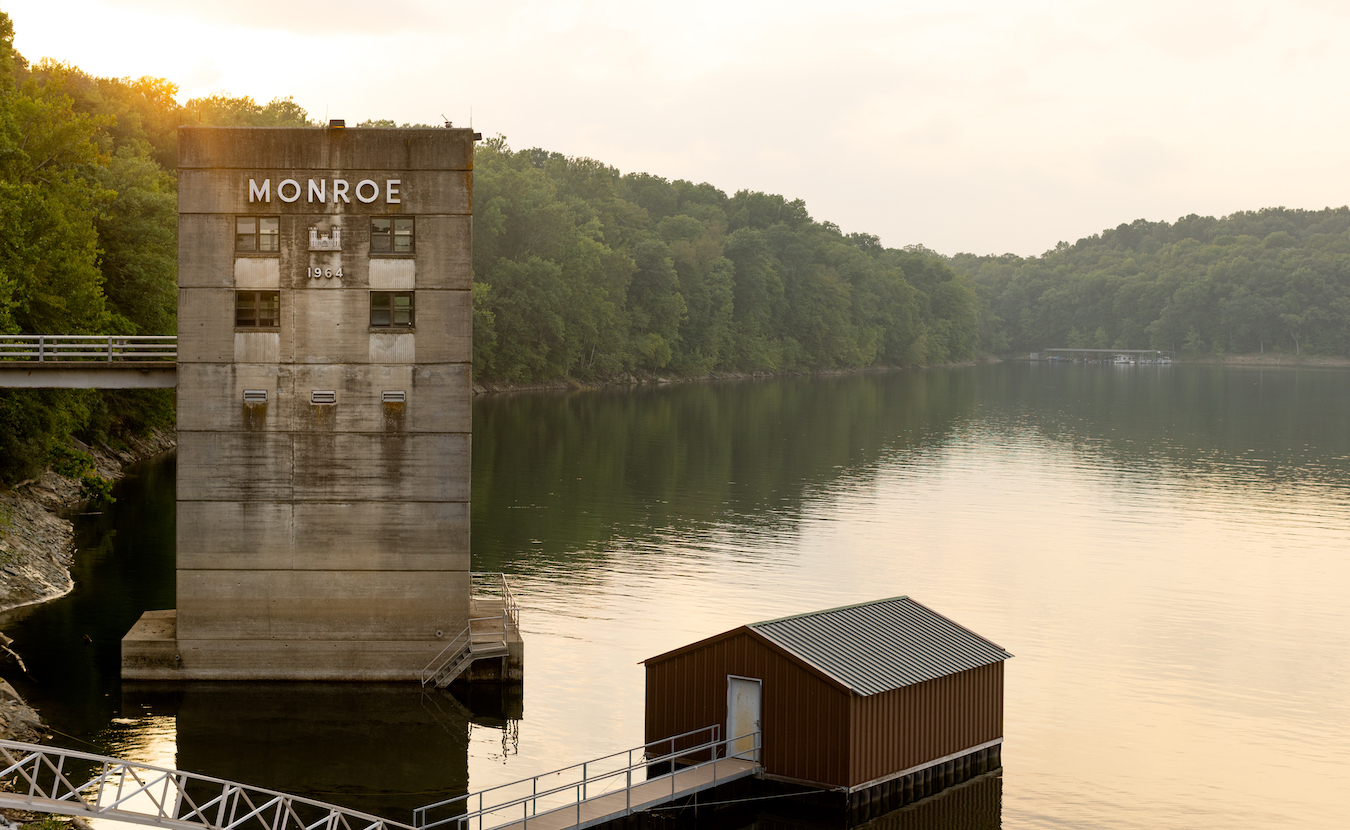Editor’s note: This is the sixth article in a series called “Deep Dive: WFHB and Limestone Post Investigate,” a collaboration between WFHB Community Radio’s Local News Department and Limestone Post, made possible by a grant from the Community Foundation of Bloomington and Monroe County. Deep Dive has been chosen by the Institute for Nonprofit News as a Finalist for “Journalism Collaboration of the Year” in the 2023 Nonprofit News Awards. Read more about the collaboration at the end of this article.
Lucky.
That’s what we are in Bloomington. An example: some 65 years ago, the United States Army Corps of Engineers was nailing down a site to dam up Salt Creek, running northeast to southwest, about seven to ten miles south of the city. The primary reason for the dam was to control floodwaters downstream, where the creek meets the East Fork White River near Bedford. The dam would form the largest inland body of water in the state, Monroe Lake. (That’s its official name, although it’s commonly referred to as Lake Monroe and several relevant organizations use that styling, so we’ll go with the crowd in this article.) The icing on the cake was Lake Monroe would supply the city and the rest of Monroe County with a seemingly inexhaustible supply of fresh drinking water.
At about the same time, researchers and activists were finding that the Westinghouse corporation, with its capacitor manufacturing facility just west of Bloomington, was responsible for the dumping and runoff of millions of gallons of PCBs — polychlorinated biphenyls. PCBs, no longer manufactured and used in industrial processes in the United States, are notorious toxins and carcinogens. Had most of Bloomington, including the Westinghouse plant, been part of the Lake Monroe watershed, the new lake might have become a gigantic pot of poison.
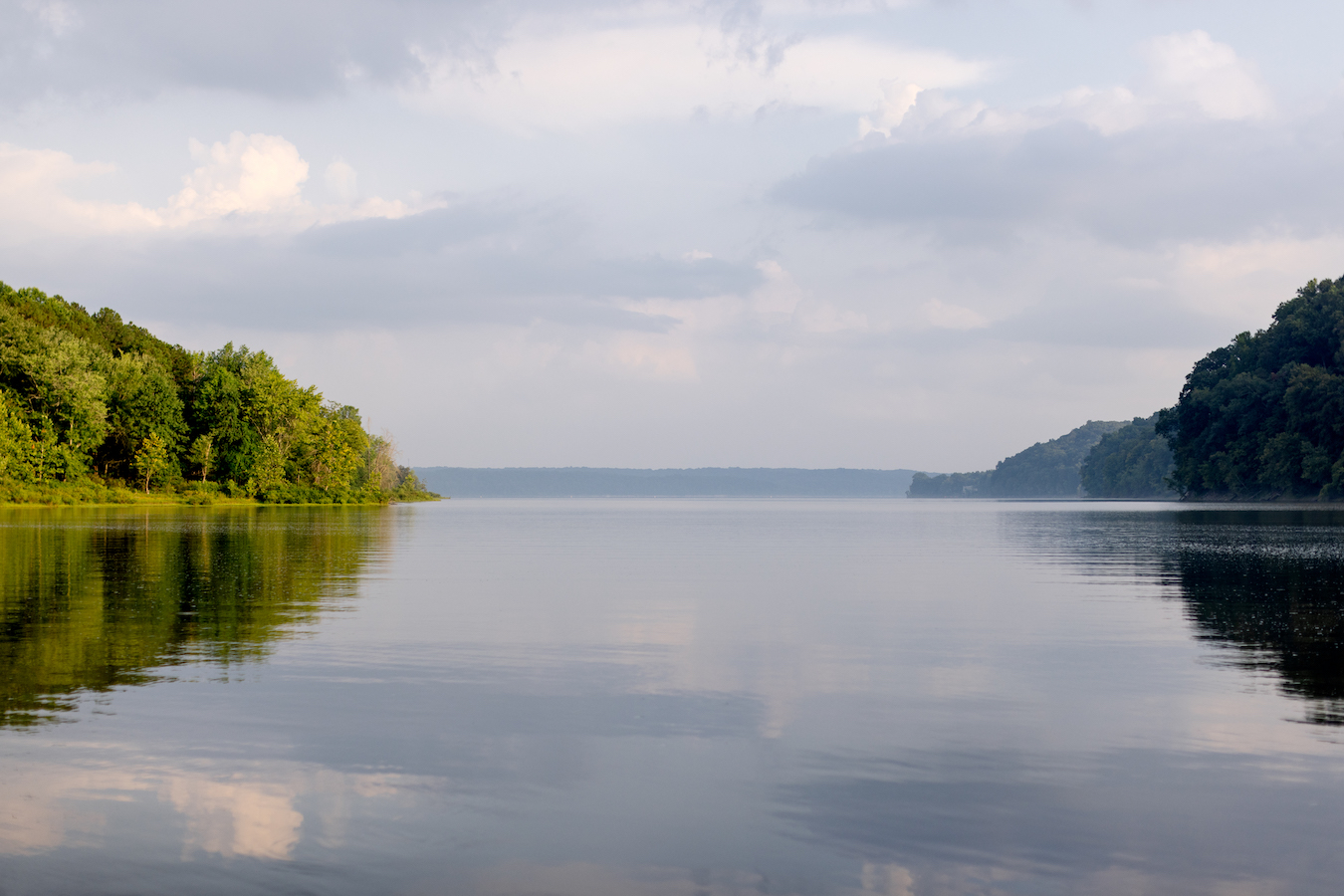
But for a bit of geologic luck, Lake Monroe might have become a gigantic pot of poison, thanks to millions of gallons of polychlorinated biphenyls, or PCBs, dumped by a Westinghouse plant located in Monroe County but just outside of the lake’s watershed. | Photo by Anna Powell Denton
Lake Monroe watershed
Just as the map of south-central Indiana is divided into counties and townships, so it is divided into a patchwork of watersheds. Water, the adage goes, always flows downhill. Created by nature rather than legislature, watersheds are clearly defined adjacent areas marking bowl-like depressions in the land in which groundwater flows toward a common point. Each watershed in our greater region is a network of streams and rivers, the lot of them converging, eventually, in the direction of the Gulf of Mexico via the Wabash, Ohio, and Mississippi rivers.
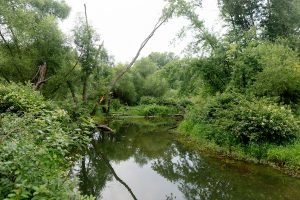
Groundwater anywhere in the 441 square miles of the Lake Monroe watershed, including Moore’s Creek (above), eventually makes its way into the lake. | Photo by Anna Powell Denton
Geology did us a favor, if Westinghouse didn’t. The overwhelming majority of the PCB soil and storm runoff flowed to the southwest, beyond the new dam and safely out of the Lake Monroe drainage basin. Our dumb luck: Bloomington lies in a different watershed than that of the lake. The carcinogens would be somebody else’s bad luck.
As luck would have it, the 140,000 residents of Monroe County can drink tap water to their hearts’ content without fear of developing cancers and other PCB-caused maladies.
So, are we in the clear? Maybe. Maybe not.
Go out in your backyard or take a stroll in a field on a rainy day. The rainwater, you’ll note, is flowing — somewhere. In the Lake Monroe watershed, that somewhere is behind the dam. So the groundwater within every inch of the Lake Monroe watershed, 441 square miles, mostly within Brown County but also including parts of Monroe, Jackson, Bartholomew, and Lawrence counties, eventually makes its way into the lake. But groundwater has a tendency to drag stuff along with it as it flows: soil, gum wrappers, animal feces, bird carcasses, decaying plant material, insecticides, weed killers, fertilizers, and more. All that makes its way into Lake Monroe.
Add to that whatever flotsam and jetsam that the 1.5 million annual boaters, swimmers, and Jet-Skiers might fling or drop into the lake, as well as dead and dying flora, fish, and amphibians, and the next time you pour yourself a glass of tap water, you might be excused for thinking twice about taking a gulp.
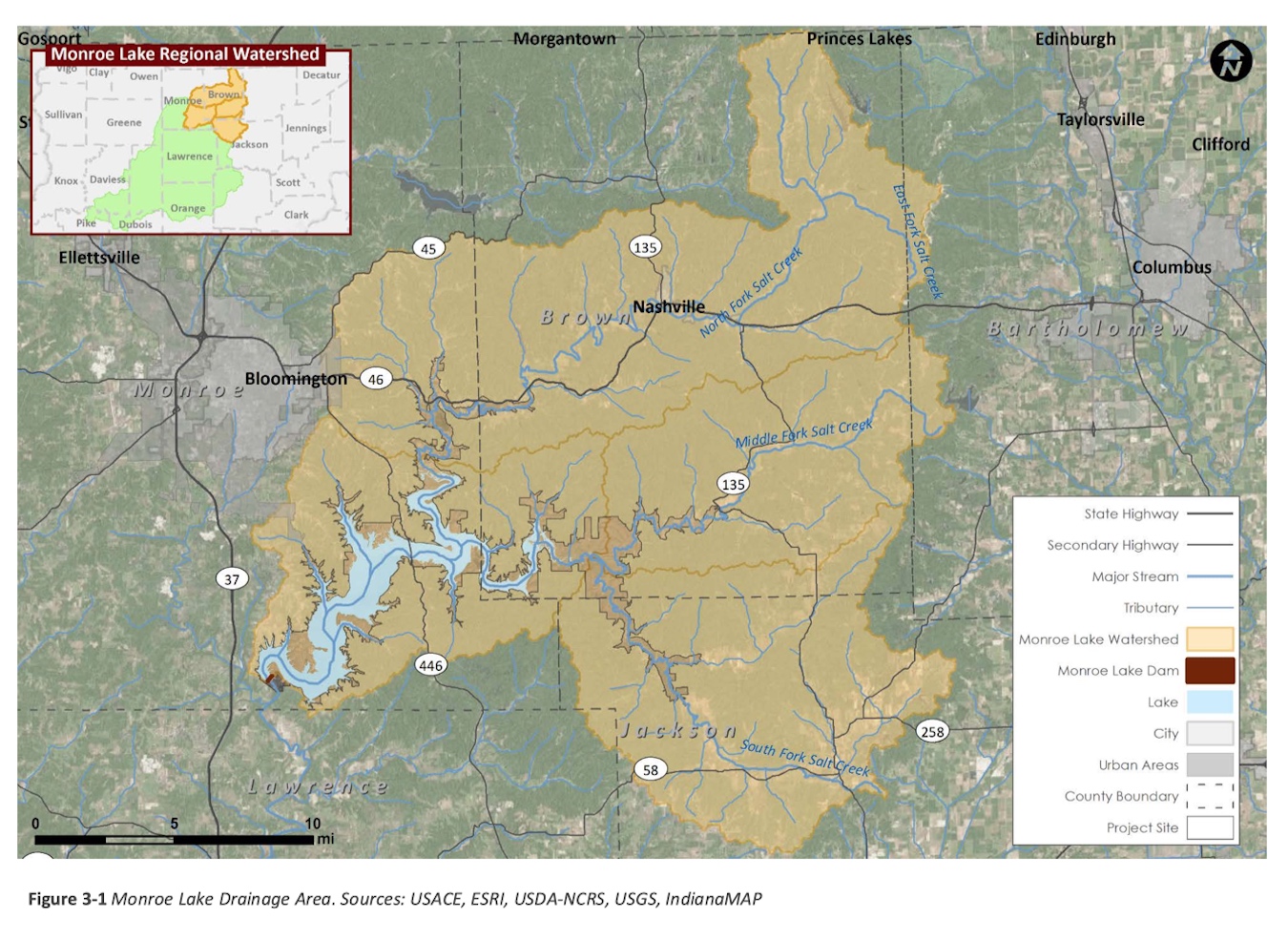
How long will the lake live?
Soon after the dam was completed and Lake Monroe was filled to its current capacity of 70–100 billion gallons of water in its 11,000-acre surface area in 1965, the city of Bloomington began building a state-of-the-art water treatment plant on Shields Ridge Road. For a few years, Bloomington and Monroe County’s drinking water came from both Monroe and Griffy lakes. The Griffy Lake water treatment plant was decommissioned in 1996. Now the primary source of drinking water for Monroe County, Lake Monroe also supplies the town of Nashville with a portion of its water. A 36-inch-wide concrete intake pipe sucks water out of the lake and runs it uphill to the treatment plant where the water undergoes what is called “conventional rapid sand” cleansing.
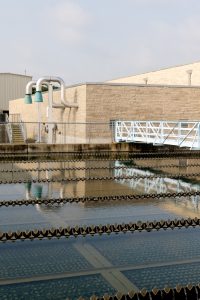
The water treatment plant on Shields Ridge Road was built in 1965 and today provides drinking water for Monroe County. | Photo by Anna Powell Denton
[Read how Lake Monroe’s water is treated in this 2016 story about the quality of local drinking water.]
By the time Lake Monroe water gets to the glass underneath your kitchen faucet, it’s been cleared and stripped of leaves, sticks, dead birds, animal droppings, fish carcasses, agricultural chemicals, gasoline, gum wrappers, and whatever else had fouled it until it reached the water treatment plant.
So far so good. “We have a utilities company that does a very good job of treating the water and monitoring that water to make sure it is clean and safe to drink,” says Maggie Sullivan, watershed coordinator for the Friends of Lake Monroe, a nonprofit advocacy group organized “to protect and enhance Lake Monroe and its watershed,” according to its mission statement.
City of Bloomington Utilities Director Vic Kelson says, “We take water samples throughout our distribution system every day to make sure that the disinfection levels are where they should be. We test the water every hour at the treatment plant. We’re always monitoring to make sure there’s enough disinfection. We measure the turbidity [the amount of cloudiness] that’s remaining in the water. We measure all those things all the time.”
A question remains: Will the treatment plant be able to keep up with challenges for the next 10, 25, or even 50 years?
In any discussion about the lake with people whose job it is to keep an eye on its water, you’ll hear, again and again, the lake was designed to last 100 years. “People talk about the life of a lake based on what they think sedimentation rates will be, until it’s filled up enough that you probably can’t use it much anymore,” says Kelson. “Streams flow in and they carry sediment, silt, and so forth. Soil.”

Maggie Sullivan is the watershed coordinator for the nonprofit advocacy group Friends of Lake Monroe. | Photo by Anna Powell Denton
“All engineered structures typically have a designated design life,” says Adam Connelly, water resources section chief for the U.S. Army Corps of Engineers, Louisville District, that oversees Lake Monroe. “At the end of this design life, it is expected some components of the structure may need to be replaced due to wear and tear or deterioration. The Monroe Dam is a robust structure that receives regular inspection and maintenance. With routine inspection and maintenance, the life of engineered structures can typically be extended well beyond their designated design life. There is currently no concern about Lake Monroe or the dam going away or being removed at any point in the near or distant future due to reaching the end of the design life.”
Nutrient pollution
For now, a filtering grate at the opening of the 36-inch intake pipe keeps the big stuff out of the city’s water supply, and the treatment plant takes care of the particulate and most known chemical pollutants. But every year — every day — more and more soil and silt, junk and gunk, flows into Lake Monroe from its watershed.
“Anything that’s on the ground can get washed into a stream when it rains,” says Sullivan. “Fertilizer on a farm field, or manure, or dog poop, or bare soil on a construction site, or oil that leaks out of cars.”
When asked what the greatest pollution threat to Lake Monroe’s water quality is at this time, Zac Wolfe, limnologist — one who studies inland water bodies — for the Army Corps, Louisville District, answers simply, “Nutrient pollution.” That is, all the phosphorous- and nitrogen-based fertilizers washing off of farm fields.
It’s all adding up, slowly pressing us closer to the day when, as Kelson warns, we won’t be able to use Lake Monroe anymore.
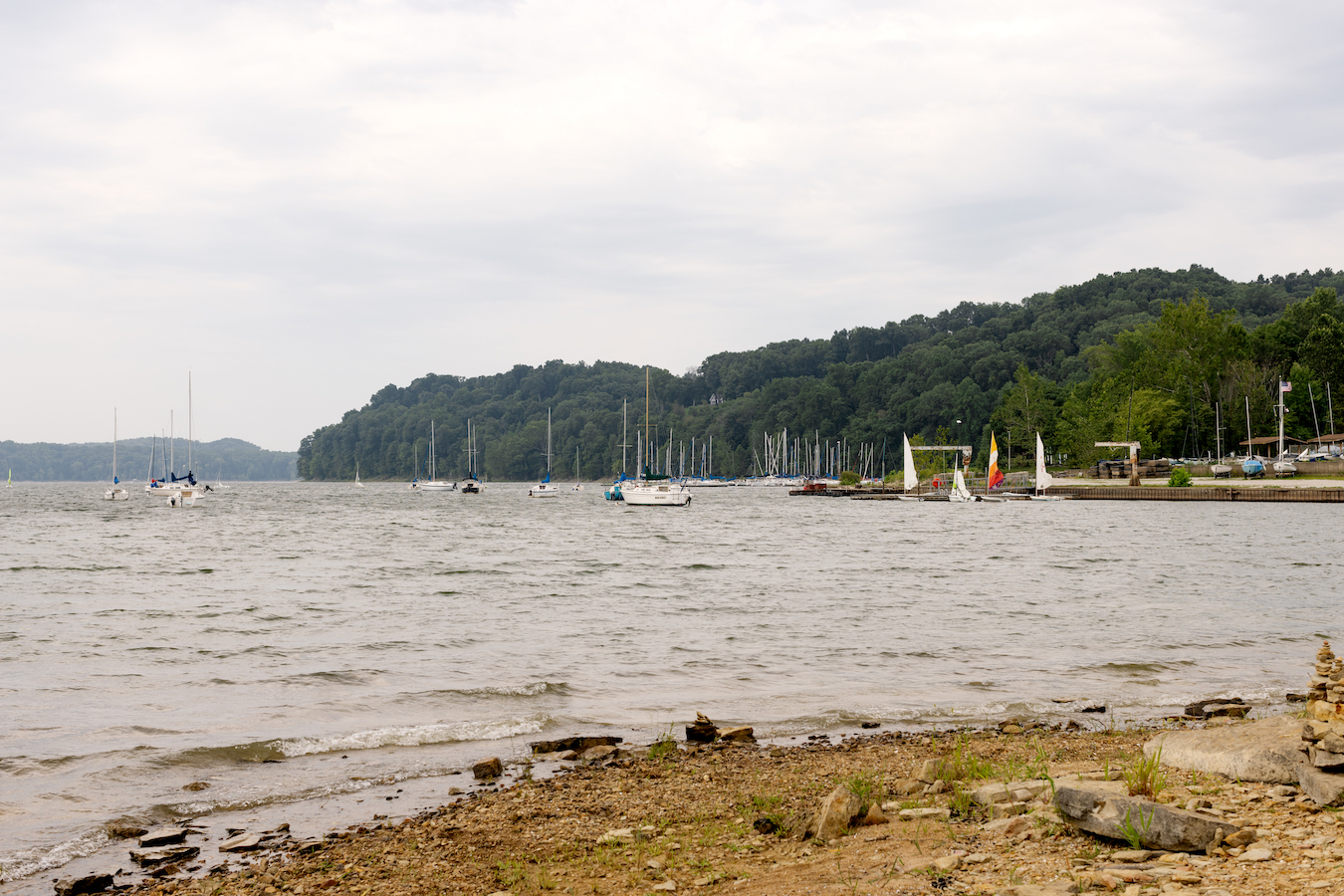
The Moores Creek Sailing Marina is operated by the Lake Monroe Sailing Association at Lake Monroe. | Photo by Anna Powell Denton
According to the Indiana Environmental Reporter, very little of the soil sediment that enters Lake Monroe leaves it. Every year more than 35,000 tons of new sediment remains in the lake. Slowly but surely, the lake bottom is filling up. (Lake Monroe’s average depth is 17 feet and its maximum depth is 54 feet, according to the Friends of Lake Monroe.)
“Lake Monroe’s water quality is in relatively decent shape,” says Michelle Cohen, executive director of the Lake Monroe Water Fund, which funds watershed conservation projects. “However, we need to put forth a concerted effort to keep it that way.”
‘10-year soil’
The Friends of Lake Monroe and the Lake Monroe Water Fund serve as point organizations, pulling together the various authorities, associations, and advocates for the lake.

Michelle Cohen is the executive director of the Lake Monroe Water Fund, which funds watershed conservation projects. | Photo by Anna Powell Denton
“We spent the last couple of years developing a watershed management program,” Sullivan says. “That is a document that says here are the issues and here are the proposed solutions. The big thing we’re focusing on is working to encourage landowners to adopt soil- and water-conservation practices. A lot of this is farm-related: helping farmers apply fertilizer in a way that minimizes runoff or planting vegetation along the edge of streams that act as a buffer that will filter runoff, fencing livestock out of streams so they’re not depositing their manure directly in them, [and] using cover crops.”
Agricultural runoff feeds the lake with nutrients that things like blue-green algae eat up. Again, we’re lucky: According to Sullivan, there are a “couple hundred very small” farms in the watershed, as well as two large farm operations. But the watershed is mostly forested land. Our luck derives from the fact that the area’s soil is not terribly conducive to farming. “We’re very hilly,” Sullivan says. Pioneer farmers discovered the south-central Indiana soil simply washed down the hills into many streams hereabouts. They called this land “10-year soil” — after ten years of farming the soil would be depleted.
Nevertheless, there are enough farm fields in the watershed to make Lake Monroe’s blue-green algae bloom almost every year.
Lousy tap water
In a March 2023 article in the New Yorker, Pulitzer Prize–winning science writer Elizabeth Kolbert asserted that the use of nitrogen- and phosphorous-based fertilizers have helped farmers feed billions of people but, after several hundred years of their use, agricultural runoff permeated with those substances imperils our lakes and rivers.
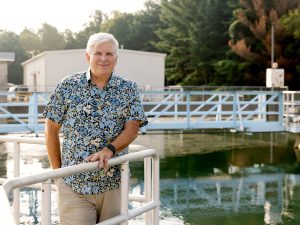
Vic Kelson, director of City of Bloomington Utilities, is shown here at the Shields Ridge Road Water Treatment Plant. | Photo by Anna Powell Denton
A study conducted jointly by the universities of Vermont, Colorado, Kansas, and Michigan and released this past spring found lakes in more than 40 states are threatened by nutrient pollution. “We hope this study is a wake-up call,” says Carol Adair, one of the lead researchers. The study found that warmer winters, more frequent rainfalls in colder months, and fewer stable seasonal snowpacks have contributed to increased fertilizer runoff from farm fields in recent years. The runoff ends up in lakes and results in bigger blue-green algae blooms in summer months.
As an example, Grand Lake St. Mary’s in Ohio, near the Indiana border, began battling blue-green algae pollution in 2010. Remedies seemed to be working, but then this past winter too much of the lake’s blue-green algae survived because of an absence of ice cover, leading authorities to issue blue-green algae warnings as early as May.
Every August through October when the water is at its warmest, Lake Monroe is home to blue-green algae blooms. A misnomer, blue-green algae is actually cyanobacteria. During those blooms, our tap water can start tasting … well, lousy.

Floc floats to the top of the water to be removed during the purifying process at the South Shields Road Water Treatment Plant. Floc consists of clay soil particles, algal cells, organic chemicals, and anything else floating in the water. | Photo by Anna Powell Denton
“When we have really high populations of blue-greens in the water,” Kelson explains, “they carry with them chemicals called geosmins and MIB [2-Methylisoborneol]. They’re not hazardous; they don’t have any health effects, but they do make the water smell and taste like the lake.” Many describe such tainted water as tasting and smelling “earthy” or “musty.”
Technicians at the Bloomington water treatment plant add more disinfectant to the water accordingly when blue-green algae bloom. The problem is, the more fertilizers and decaying flora and fauna enter the lake, the more blue-green algae will bloom. The cyanobacteria thrive on that stuff.
“More frequently-occurring algal blooms in the late summer warn us that we need to reduce nutrients flowing into the lake,” says Cohen. “Nutrients like phosphorous and nitrogen can come from fertilizer and errant septic discharge. These feed algal blooms. Dirt or sediment can carry nutrients and settle in the lake, slowly filling it, so it’s important to reduce erosion, too.”
“When they are happy, they just explode exponentially,” says Sullivan of lake algae. “They use up a lot of oxygen, which can cause problems for other animals in the lake. They grow in large quantities and now you have all this extra organic material. That makes it hard for the water treatment plant to generate clean drinking water. Some blue-green algae can produce toxins. That is when we start to worry about swimming in the water.”
No dog paddling?
Some of the many different types of algae can cause illness. “There are numerous Harmful Algal Bloom [HAB] toxins,” writes Brad Reisfeld, public health, chemistry, and biology professor at Colorado State University. Symptoms can range from stomach pain, vomiting, diarrhea, headache, fever, fatigue, skin, eye or throat irritation, and neurological symptoms like muscle weakness or dizziness. Depending on the toxin, higher levels of exposure can result in tremors or seizures, respiratory distress, kidney toxicity, liver toxicity, and even death. Exposure occurs through swimming, boating, and even inhaling airborne water droplets.
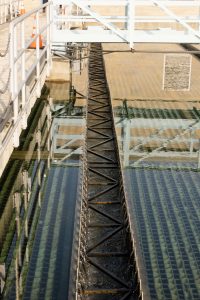
Water flows through V-notch weirs during the last step of the purifying process at the South Shields Road Water Treatment Plant. This helps trap and remove any remaining pollutants. | Photo by Anna Powell Denton
Lake Monroe is home to several varieties of non-blue-green algae, including green, brown, and several other algae. Kelson isn’t worried about the lake’s resident algae varieties. “They do not release taste and odor chemicals, toxins, or other chemical species that negatively affect water quality. They are simply removed via sedimentation and filtration of the water during treatment.”
Ginger Murphy, deputy director, division of state parks for the Indiana Department of Natural Resources, says native algae species other than blue-green aren’t a big local worry at this time. “I am not aware of any significant recent direct impacts at Monroe Lake,” she says.
Murphy, though, warns us about taking our pets to the lake for a cooling swim. “When blue-green algae die, they can produce toxins that can impact other species. In general, we say that livestock, pets, and wild animals can be impacted by these toxins. Dogs are particularly susceptible to blue-green algae poisoning because the scum can attach to their coats and be swallowed during self-cleaning,” she says.
As for wilder critters, Murphy adds, “We have not seen specific impacts on native mammal species at Monroe Lake.” We might add “yet” to that statement.
Ceaseless vigilance seems to be the best — maybe the only — way to keep our good fortune going.
It takes a community
Of all the problems facing Lake Monroe, climate change may be the toughest to address.
“Extreme weather conditions are increasing, and precipitation is projected to become more frequent and intense in Indiana, especially during winter and spring,” Cohen says. “This poses a particular challenge for us because we have steep slopes in the watershed, making runoff move much faster than on flatter land, carrying more sediment and nutrients farther. Summer and fall may become drier, heightening the chances for more and larger algal blooms.”
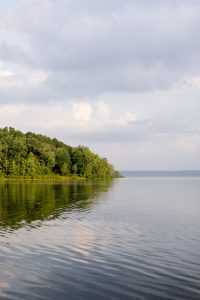
Steep slopes in the watershed pose a particular challenge, Cohen says, because they make runoff “move much faster than on flatter land, carrying more sediment and nutrients farther.” | Photo by Anna Powell Denton
Sullivan says, “When we see heavy rain events in the wintertime, that’s when the soil is the least protected. That’s when we don’t have leaves on the trees that would slow the water down, we don’t have crops growing on our cropland, and so there’s much more potential for that water to hit the ground, find some bare soil, and wash it into our streams. If the soil’s saturated, it’s just going to run right off. That’s a concern that we anticipate getting worse with climate change.
“Then, on the flip side, if we’re having more hot, dry summers, then we’re increasing those conditions that blue-green algae like, and making it more likely they’re going to really take off and cause some problems.”
Zac Wolfe adds: “Climate change will likely increase extreme algal blooms due to larger rain events, longer drought periods, and increased temperatures. The die-offs of algal blooms can cause massive depletion of dissolved oxygen in the water, which can kill aquatic organisms like fish. Also, changing patterns of temperature and dissolved oxygen may alter other constituents of the water, such as metals that typically bond to lake sediments but could be re-suspended into the water column.”
None of the organizations or authorities can tackle all the problems facing Lake Monroe alone. Wolfe says the U.S. Army Corps’ immediate emphasis is “monitoring and partnering with various agencies to evaluate potential opportunities to maintain or improve water quality.”
In other words, it takes a community.
“There is no entity that controls the watershed,” says Sullivan. “That’s part of the reason why it’s helpful to have a watershed coordinator. There are a lot of groups involved. There are tons of private landowners in the watershed. There are multiple counties that have jurisdiction. There’s the town of Nashville. A little bit of the city of Bloomington. So there’s no one person that can come in, no one organization that can say, Everyone in the watershed needs to do X.”
Water monitors

Photo by Anna Powell Denton
You can keep an eye on Lake Monroe’s water quality without leaving the comfort of your sofa. Several water quality monitoring sites are available online. They include:
- The City of Bloomington Utility Department’s Water Quality Information page
- The state’s Reservoir and Lake Sampling Update for blue-green algae
- The Kentucky Division of Water — an authority that includes Lake Monroe — Harmful Algae Bloom Viewer
- Army Corps of Engineers’ temperature and dissolved-oxygen levels at various depths profile in Lake Monroe
—M.G.G.
The luck and the irony of Lake Monroe
Lake Monroe isn’t unique among the world’s water bodies. Global pollutants include PFAS (per- and polyfluorinated substances — microscopic particles from plastic coatings and polymer products that resist heat, oil, stains, grease, and water) and prescription drugs like Prozac, Xanax, birth control pills, and more. Tests around the world have found traces of the drugs in lakes and streams. Methamphetamines also have been found in the world’s waters. Right now, none of these pollutants is viewed as an immediate threat in Lake Monroe. As their presence in the world’s waters increases, we’ll have to take them into account.
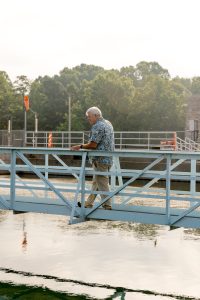
Kelson says water samples are taken every day throughout the utility’s distribution system, and water is tested every hour at the treatment plant. | Photo by Anna Powell Denton
Bloomington’s utilities department does monitor for COVID in treated wastewater at its two wastewater treatment plants. The level of COVID in sewage can indicate a coming rise in the infection. “We do bi-weekly sampling,” Kelson says. “We were one of the first few utilities in the state to start doing that and one of two that have continued doing it continuously since then. The biochemical evidence that a person has COVID ends up in fecal material even before you start sneezing. So, wastewater sampling is considered predictive of what’s coming up. We’ve been having really low numbers lately so, knock wood, it’ll stay that way. Those data are published every week.”
Again, our good luck: Bloomington’s wastewater does not flow into the Lake Monroe watershed. The city’s wastewater is treated at the Dillman Road and Blucher Poole treatment plants and then released into Clear Creek, downstream from the Lake Monroe dam.
Here’s an irony, though: Our luck may be too good. Several sources whose job it is to push for more stringent practices that protect Lake Monroe’s water say the relatively good quality of its water makes their job harder than it would be if the lake was a mess. The more we convey how clean Lake Monroe’s water is, the more likely residents, farmers, and industries within its watershed will think they don’t need to take extraordinary or even nominal precautions to keep it that way. These sources stress continued agricultural runoff and climate change will indeed foul Lake Monroe more than it already is. Their message is, Why don’t we act today to prevent the lake from becoming dangerously polluted tomorrow?
U.S. Forest Service’s Houston South Project
 With so much of Lake Monroe’s watershed dominated by forest, much of it under the control of the U.S. Department of Agriculture’s Forest Service, a recent lawsuit merits attention. The Forest Service in February 2020 announced a 15-year vegetation management and restoration program for 15,000 acres in the Hoosier National Forest, originally set to begin this past April. Known informally as the Houston South Project, it includes logging, controlled burns, and other alterations to the forest, some of it within the Lake Monroe watershed. The Indiana Forest Alliance, the Monroe County Board of Commissioners, and the Hoosier Environmental Council filed a lawsuit in May 2020, calling for the Forest Service to look deeper into the project’s environmental effects, including potential erosion and runoff caused by the loss of trees. The Friends of Lake Monroe later joined as a plaintiff.
With so much of Lake Monroe’s watershed dominated by forest, much of it under the control of the U.S. Department of Agriculture’s Forest Service, a recent lawsuit merits attention. The Forest Service in February 2020 announced a 15-year vegetation management and restoration program for 15,000 acres in the Hoosier National Forest, originally set to begin this past April. Known informally as the Houston South Project, it includes logging, controlled burns, and other alterations to the forest, some of it within the Lake Monroe watershed. The Indiana Forest Alliance, the Monroe County Board of Commissioners, and the Hoosier Environmental Council filed a lawsuit in May 2020, calling for the Forest Service to look deeper into the project’s environmental effects, including potential erosion and runoff caused by the loss of trees. The Friends of Lake Monroe later joined as a plaintiff.
Marion Mason, public affairs specialist for the Forest Service, says, “The actions to be implemented under the Houston South Restoration project are critical for the long-term benefit, diversity and resilience of our public forests and the habitats they provide for wildlife.” Houston South, Mason adds, would embody a range of smaller projects that include improving culverts and repairing roads and trails that now are contributing to sediment runoff into streams.
U.S. District Court Chief Judge Tanya Walton Pratt in March of this year granted the plaintiffs an injunction, halting Houston South until the suit could be adjudicated.
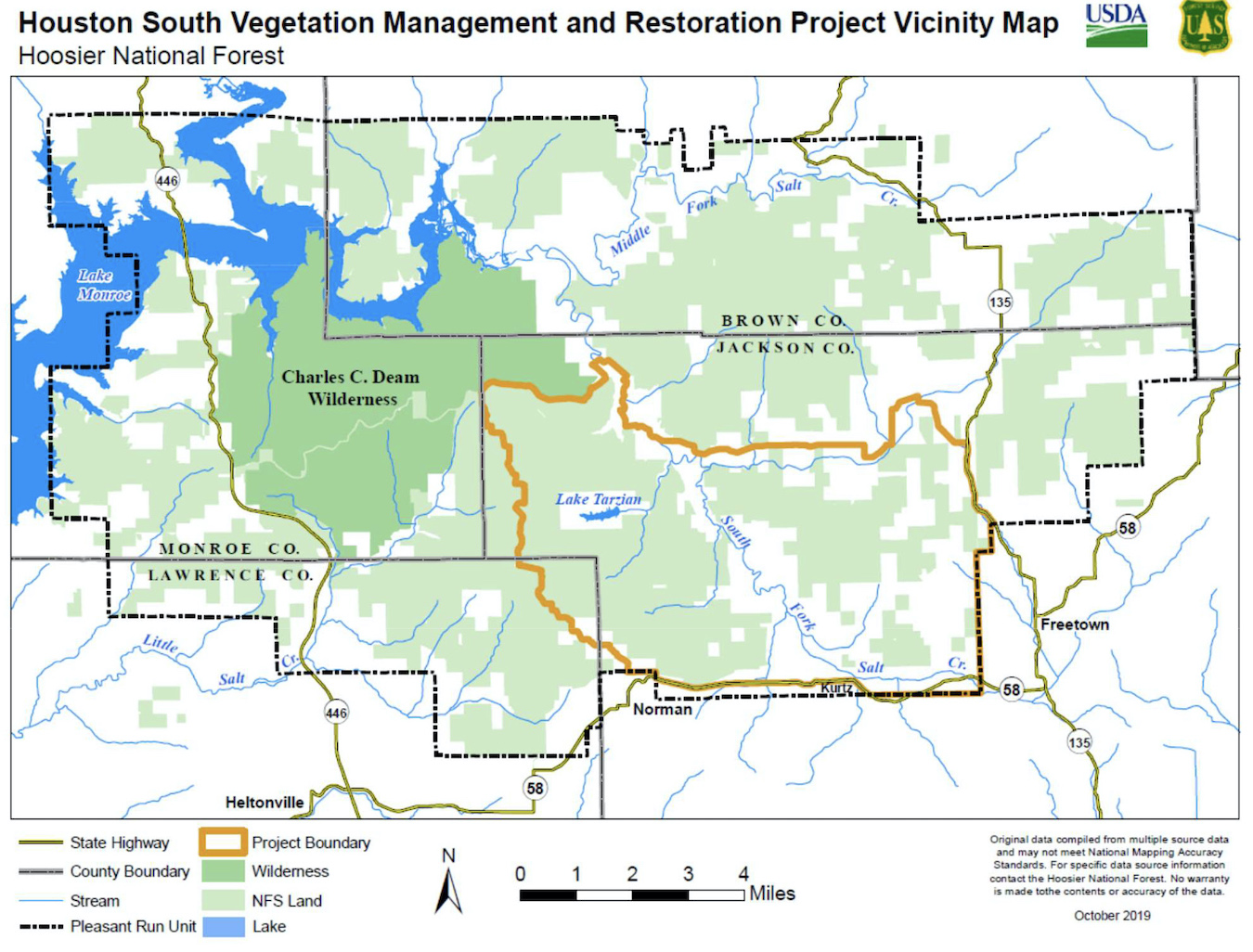
Houston South project
The gist of the lawsuit was the plaintiffs’ desire to compel the Forest Service to conduct an Environmental Impact Statement, one of several documents mandated by the 1969 National Environmental Policy Act (NEPA) for federal projects that might pose a risk to the surrounding human and natural environment. All project managers must submit a preliminary Environmental Assessment that characterizes the end result of the work as either posing no environmental threat or delineating the extent to which it would and offering alternatives to the project. The Forest Service had submitted an Environmental Assessment claiming Houston South would not endanger the lake.
Judge Pratt ruled that the Forest Service had failed “to take the legally required ‘hard look’ at the direct, indirect, and cumulative impacts of the Project on Lake Monroe in its final Environmental Assessment, and had therefore failed to make a convincing case that the Project’s impacts on Lake Monroe were insignificant and could avoid scrutiny in a more rigorous Environmental Impact Statement.”
On June 27, the litigants agreed to a settlement, with the Forest Service promising to further evaluate the potential environmental effects resulting from Houston South. The Forest Service also agreed to pay for the plaintiffs’ legal fees and costs.
A lake’s life
Lake Monroe is like any other aging codger. Its health must be watched, its intake monitored, its illnesses promptly addressed.
“Lake Monroe is a reservoir,” Michelle Cohen says, “and all reservoirs eventually fill up. We need to be mindful that its lifespan isn’t forever, but that we have the power to extend it as long as possible. Just like humans who incorporate healthy habits live longer, the lake can ‘live’ longer if we practice activities that are healthy in the areas that drain into the lake. Following the old adage, ‘an ounce of prevention equals a pound of cure,’ better incoming water quality reduces the expense of treating the water to acceptable drinking water standards.”
“I’m optimistic,” says Maggie Sullivan. “I’m very excited that we’re seeing a lot of support for this work, a lot of people who care, who want to make an impact. It’s possible to protect the lake and improve the lake.”
“We’re lucky to have Lake Monroe for lots and lots of reasons,” Kelson says. “We need to take care of it. We know it won’t be there forever, but we need to have plans for what we might do a hundred years from now.”
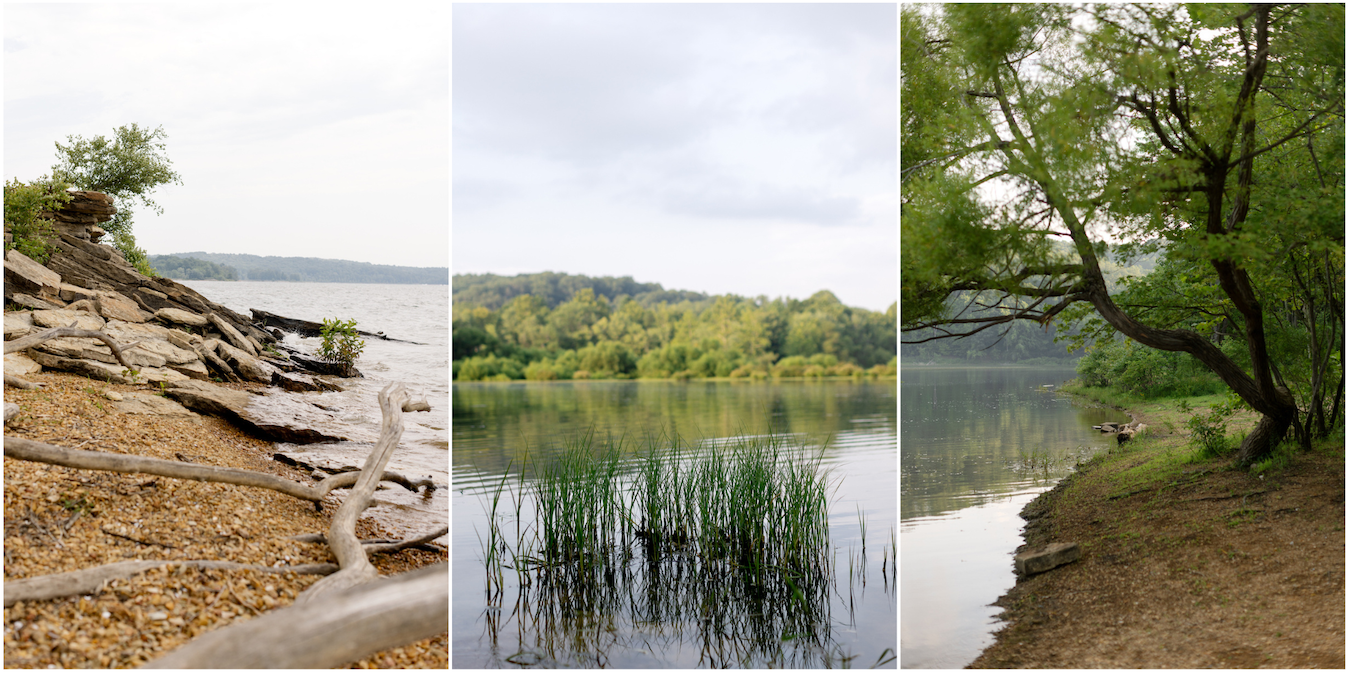
Lake Monroe | Photos by Anna Powell Denton
Healthy Lake Monroe Programs
The Lake Monroe Water Fund and the Friends of Lake Monroe offer a variety of ways for the public to get involved with cleaning up the lake’s waters — and making sure they stay that way.
Here are some of the programs and projects that the two organizations have instituted to help keep Lake Monroe’s water safe and drinkable:
Lake Monroe Water Fund
 Healthy Woodlands for Clean Drinking Water — LMWF has planted 600 willow cuttings and 900 native trees and shrubs at CYO Camp Rancho Framasa to hold soil, slow down runoff, and take in excess water. Funded by grants from the Duke Energy Foundation and the Smithville Charitable Foundation
Healthy Woodlands for Clean Drinking Water — LMWF has planted 600 willow cuttings and 900 native trees and shrubs at CYO Camp Rancho Framasa to hold soil, slow down runoff, and take in excess water. Funded by grants from the Duke Energy Foundation and the Smithville Charitable Foundation
- A septic system maintenance cost-share program providing $200 reimbursements for tank pumping, inspection, or riser installation, in partnerships with the Brown County Soil and Water Conservation District
- Free soil testing for +500 landowners in partnership with the Monroe County Soil and Water Conservation District to reduce nutrient runoff by reducing fertilizer use. Funded through a grant from the Community Foundation of Bloomington and Monroe County
Friends of Lake Monroe
 Conservation Cost-Share Program — Funding 75 percent of landowners’ total cost for cover crops, conservation tillage, nutrient management, tree buffers, foliage cover, and other runoff protections
Conservation Cost-Share Program — Funding 75 percent of landowners’ total cost for cover crops, conservation tillage, nutrient management, tree buffers, foliage cover, and other runoff protections
- Community Action Initiative — public forums, community group presentations, a watershed summit scheduled for October 2023, a septic system cost-share program, and a general publicity campaign to create awareness of the watershed
- Water clarity monitoring, quantifying sediment, monthly public meetings with guest speakers, Adopt-a-Shoreline Cleanup, kayak tours
—Michael G. Glab
Update: LEARN ABOUT SOIL CONSERVATION AT UPCOMING FIELD DAY
An agricultural field day titled “Conservation Across Generations” will be held on Friday October 20 from 8 a.m. to noon at Valley View Farms in Monroe County, according to a press release by Friend of Lake Monroe. Third generation cattle and grain farmers Clint and Justin Conard will showcase the conservation legacy begun by their grandfather Dale Conard and how they have integrated new information and technology. They will also demonstrate cover crop seeding and discuss their experience with equipment modification and seed selection.
This event is free and includes a free barbecue chicken lunch but participants must register by October 10 at https://tinyurl.com/1020fieldday. Doors open at 8 a.m. and the first presentation will start at 8:45. This event is being hosted by the Monroe County Soil & Water Conservation District with support from Friends of Lake Monroe, the Brown County Soil & Water Conservation District, Conservation Cropping Systems Initiative, and the Alliance of Indiana Rural Water.
“We are excited to showcase Monroe County farmers who are actively pursuing environmentally sound conservation practices,” said Martha Miller, Monroe County Soil & Water Conservation District Manager. “Field days provide an excellent opportunity for farmers to see conservation practices in action and to learn from other farmers.”
The event will also feature information about funding opportunities for conservation work. Friends of Lake Monroe launched the Lake Monroe Watershed Conservation Cost-Share Program last fall. Farmers in the watershed (which spans portions of Monroe, Brown, and Jackson counties) can receive up to 75 percent reimbursement of expenses from select conservation practices.
The cost-share program is part of a larger initiative documented in the Lake Monroe Watershed Management Plan, released in January 2022. Friends of Lake Monroe is working to reduce the amount of sediment, nutrients, and fecal contamination reaching the lake by pursuing multiple projects across the watershed. Adopting conservation practices is a key strategy for protecting and improving water quality in Lake Monroe and its tributaries. Other strategies include addressing septic system failure, planting permanent vegetation along streams, and restoring floodplain wetlands. To learn more, visit friendsoflakemonroe.org or contact Watershed Coordinator Maggie Sullivan at 812-588-0217.
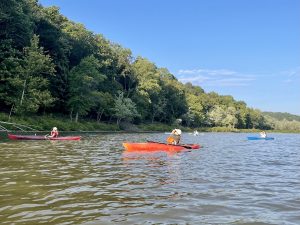
Photo by David Rupp
WHEREAS …
Commissioners in Monroe, Jackson, and Brown counties and the City of Bloomington have all officially proclaimed Sunday, September 17, 2023, to be “Lake Monroe Day.” Friends of Lake Monroe will celebrate with a week of events, September 14-21. Activities include hiking, biking, paddling, picking up trash, and touring the water treatment plant. A community celebration will be held on Sunday, September 17, at Upland Wood Shop, 354 W. 11th St. in Bloomington, at 5:30 p.m. Visit friendsoflakemonroe.org/events for more details and to register for events.
 Deep Dive: WFHB & Limestone Post Investigate
Deep Dive: WFHB & Limestone Post Investigate
The award-winning series “Deep Dive: WFHB and Limestone Post Investigate” is a journalism collaboration between WFHB Community Radio’s Local News Department and Limestone Post Magazine. Deep Dive debuted in February 2023 as a year-long series, made possible by a grant from the Community Foundation of Bloomington and Monroe County. The Community Foundation also helped secure a grant from the Knight Foundation to extend the series for another year.
In the series, Limestone Post publishes an in-depth article about once a month on a consequential community issue, such as housing, health, or the environment, and WFHB covers related topics on Wednesdays at 5 p.m. during its local news broadcast.
In 2023, Deep Dive was chosen by the Institute for Nonprofit News as a finalist for “Journalism Collaboration of the Year” in the Nonprofit News Awards held in Philadelphia. And this year, the series brought home seven awards from the “Best in Indiana” Journalism Contest by the Society of Professional Journalists. Read more about the awards.
Here are all of the the Deep Dive articles and broadcasts so far:
Housing Crisis
Limestone Post article by Steve Hinnefeld, published February 15, 2023:
Deep Dive: Struggling with Housing Supply, Stability, and Subsidies, Part 1
WFHB reports:
Steve Hinnefeld won 1st place for “Non-Deadline Story or Series” in the Indiana Pro Chapter of the Society of Professional Journalists “Best in Indiana” Journalism Contest for parts 1 and 2 of this housing series. The staff of WFHB won 2nd place for “Coverage of Social Justice Issues” for its programs “Deep Dive: Housing Crisis.”
Housing Crisis Solutions
Limestone Post article by Steve Hinnefeld, published March 15, 2023 | photography by Jim Krause
‘No Silver Bullet’: Advocates, Officials Use Many Tactics on Housing Woes
WFHB reports:
Opioid Settlement Fund Investigations
Limestone Post article by Rebecca Hill, published April 12, 2023 | photography by Benedict Jones
How Will Opioid Settlement Monies Be Spent — and Who Decides?
WFHB reports:
IU Tree Inventory
Limestone Post article by Laurie D. Borman, published May 17, 2023 | photography by Jeremy Hogan
Trees Do More Than Add ‘Charm’ to IU Campus
WFHB reports:
Indiana Power Grid
Limestone Post article by Rebecca Hill, published June 21, 2023 | photography by Benedict Jones
The Power Struggle in Indiana’s Changing Energy Landscape
Rebecca Hill won 1st place for “Medical or Science Reporting” in the Indiana Pro Chapter of the Society of Professional Journalists “Best in Indiana” Journalism Contest for this article.
WFHB reports:
Lake Monroe Survival
Limestone Post article by Michale G. Glab, published August 16, 2023 | photography by Anna Powell Denton
How Healthy Is Lake Monroe — and How Long Will It Survive?
Michael G. Glab won 3rd place for “Business or Consumer Affairs Reporting” in the Indiana Pro Chapter of the Society of Professional Journalists “Best in Indiana” Journalism Contest for this article.
WFHB reports:
Indiana Lawmakers Attack Public Schools
Limestone Post article by Steve Hinnefeld, published September 13, 2023 | photography by Garrett Ann Walters
Local Parents, Educators Face ‘Attack’ on Public Schools from Indiana Lawmakers
WFHB reports:
On Saving the Deam Wilderness
Limestone Post photo essay by Steven Higgs, published October 18, 2023
On Saving the Deam Wilderness and Hoosier National Forest | Photo Essay
Steven Higgs won 2nd place for “Multiple Picture Group” in the Indiana Pro Chapter of the Society of Professional Journalists “Best in Indiana” Journalism Contest for this photo essay.
WFHB reports:
Food Insecurity, Part 1
Limestone Post article by Christina Avery and Haley Miller, photography by Olivia Bianco, published December 18, 2023
One Emergency from Catastrophe: Who Struggles with Food Insecurity?
Christina Avery and Haley Miller won 1st place for “Coverage of Social Justice Issues” in the Indiana Pro Chapter of the Society of Professional Journalists “Best in Indiana” Journalism Contest for this article.
WFHB reports:
Food Insecurity, Part 2
Limestone Post article by Christina Avery and Haley Miller, photos by Olivia Bianco, published March 13, 2024
‘Patchwork’ of Aid for Food Insecurity Doesn’t Address Its Cause
WFHB report:
What’s at Stake in the Debate Over Indiana’s Wetlands
Limestone Post article and photos by Anne Kibbler, published May 15, 2024
What’s at Stake in the Debate Over Indiana’s Wetlands?
WFHB reports:
- Wetlands (Part 1), May 22, 2024
- Wetlands (Part 2), May 29, 2024
- Wetlands (Part 3), June 7, 2024
- Wetlands (Part 4), June 12, 2024


